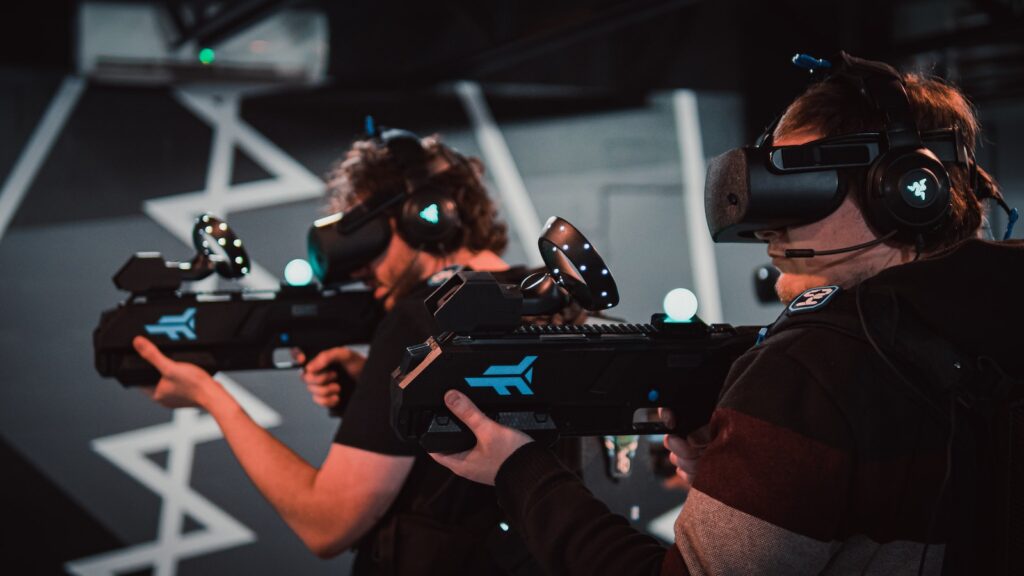
There are several VR add-on available and in-development that can enhance the immersion experience in virtual reality. Some of these include:
Sense of smell
Olfactory virtual reality (OVR) is a technology that aims to replicate the sense of smell in virtual reality. This is achieved by using a device known as an olfactory display, which can produce a wide range of scents in real-time and sync them with the virtual environment being experienced. OVR works by using different scents, such as essential oils or fragrance compounds, which are dispensed into the air by the olfactory display. The scents are produced in real-time, based on the virtual environment being experienced, and are timed to coincide with specific events or actions that take place within the VR environment. For example, if a user is walking through a virtual forest, the olfactory display might produce the scent of pine trees or fresh earth to enhance the immersion of the virtual environment.
The use of OVR can add to the overall immersion of a VR experience by replicating the sense of smell, which is a powerful tool for evoking memories and emotions. This technology can enhance the overall sensory experience of VR by allowing users to smell virtual environments and objects, just as they would in the real world. This can be especially useful in games, films, and other interactive experiences where scent can play a significant role in setting the mood or evoking a specific emotion.
Haptic suit
A haptic suit, also known as a full-body haptic feedback suit, is a wearable device that provides sensory feedback to the user through vibrations, pressure, and other tactile sensations. The suit is designed to cover the entire body, and it works by using actuators and sensors to simulate the sensation of touch, pressure, and other physical sensations.
In virtual reality, a haptic suit can be used to add to the overall immersion of the experience by simulating physical sensations in the virtual environment. For example, if a user is walking on rough terrain in a virtual world, the haptic suit could simulate the sensation of uneven ground underfoot. If a user is shot in a virtual reality game, the haptic suit could simulate the sensation of a physical impact. These types of sensory feedback can make the VR experience feel more realistic and immersive, as the user is able to physically feel the virtual environment they are in.
Haptic gloves
Haptic gloves are wearable devices that provide tactile feedback to the user’s hands in virtual reality. These gloves typically use a combination of sensors, actuators, and other technologies to simulate the sensation of touch, pressure, and other physical sensations in the virtual environment. In virtual reality, haptic gloves can be used to add to the overall immersion of the experience by allowing users to feel and interact with virtual objects and environments in a more natural and intuitive way. For example, if a user is holding a virtual weapon in a VR game, the haptic gloves could simulate the sensation of holding a physical weapon, such as the weight and recoil of the weapon when fired. If a user is handling virtual tools or objects, the haptic gloves could simulate the sensation of holding and using real-world tools, such as the sensation of turning a wrench or manipulating a joystick. Haptic gloves can also be used to provide additional feedback for specific actions, such as the sensation of pressing buttons, pulling triggers, or manipulating virtual objects. This can be especially useful in gaming and simulation applications, where it’s important for users to have a realistic and immersive experience.
VR Body tracker
Body tracking in virtual reality refers to the technology that tracks the movements and actions of a user’s body within a virtual environment. This is achieved through the use of sensors, cameras, or other tracking technologies that can capture and transmit the user’s movements in real-time.
In virtual reality, body tracking can add to the overall immersion of the experience by allowing users to physically interact with the virtual environment in a more natural and intuitive way. For example, if a user is playing a VR game that involves hand gestures, the body tracking technology would allow the user’s virtual hands to mirror their physical movements in real-time. This allows for a more immersive experience, as the user’s actions and movements within the virtual environment are directly tied to their physical movements in the real world.
Body tracking can also be used to track more complex movements, such as head movements, body posture, and the orientation of the user’s limbs. This can be especially useful in simulation and training applications, where it’s important for users to have a realistic and immersive experience.
VR Locomotion
Locomotion in virtual reality refers to the technology that allows users to move and navigate within a virtual environment. This can include various methods of movement, such as walking, running, flying, or teleportation. In virtual reality, locomotion can add to the overall immersion of the experience by allowing users to physically explore and navigate virtual environments in a more natural and intuitive way. For example, if a user is playing a VR game that involves exploring a virtual world, they would be able to physically walk or run through the environment, just as they would in the real world. This allows for a more immersive experience, as the user’s movements within the virtual environment are directly tied to their physical movements in the real world.
Teleportation is a common method of locomotion in VR, especially for users who may experience discomfort or nausea with more physical forms of movement. In teleportation, the user is able to instantly move from one location to another within the virtual environment, allowing for a more comfortable and accessible experience.
Backpack PC
A backpack PC is a type of computer that can be worn on a user’s back and is designed to support virtual reality (VR) experiences. This type of device is used to power VR headsets and provide an untethered, wireless VR experience. In virtual reality, a backpack PC can add to the overall immersion of the experience by allowing users to physically move and interact with the virtual environment without being tethered to a desktop computer. With a backpack PC, users can move freely within the virtual environment, allowing for a more natural and immersive experience.
Gun stock
A gun stock is a type of accessory used in virtual reality (VR) gaming to provide a more realistic and immersive experience. It is designed to resemble the handle and trigger mechanism of a real firearm and can be attached to a VR controller or paired with a VR headset. In virtual reality, a gun stock can add to the overall immersion of the experience by allowing users to physically hold and aim a virtual firearm, just as they would in the real world. This can greatly enhance the realism and excitement of VR shooting games and other similar experiences, making them more immersive and engaging for the user.
The use of a gun stock can also improve the accuracy and precision of aiming in VR shooting games, allowing for a more challenging and competitive experience. In addition, many gun stocks are designed with adjustable grips and other customization options, allowing users to find the most comfortable and intuitive fit for their personal preferences.
Motion platform










































